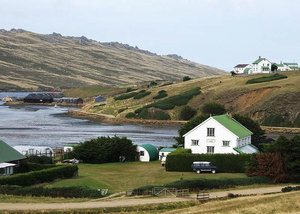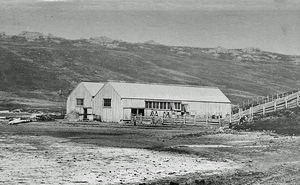WALDRON, JAMES LOVEGROVE
1829 - 1901 from England
colonist, was born, like his brother Henry, at Marridge Hill in Wiltshire, the second son of John and Jane Waldron. When he was in his thirties he travelled to Australia, New Zealand and South America to find a suitable place to establish a new sheep farm and in August 1866 applied for seven sections of 6,000 acres each on West Falkland. Although this was an application in excess of the amounts allowed by law, Governor ROBINSON recommended its acceptance, partly to counter-balance the holdings of the FIC. Waldron arrived at Port Howard in September 1867 on the barque Diana with Exmoor sheep from England and Merinos from Montevideo. Timber buildings arrived in sections (one of which is still standing at Port Howard). James Waldron's notebook for 1866/67 survives, giving insights into some of the difficulties he encountered.
Although the FIC refused to sell him sheep, his estates prospered. Governor D'ARCY wrote in his Blue Book report of 1872: 'The islands are better adapted for sheep rather than for cattle. This discovery was made by Mr.Waldron of the West Falklands and is now universally recognised.'
In 1876 FE COBB reported to the FIC's directors:
Mr W has doubtless spent thousands of pounds in starting his place and has a good deal to show for his money, though in my opinion his expenditure had often been lavish and in many instances ill-considered. ...altogether his establishment must be fully worth £200,000.
Governor KERR thought highly of him and suggested him as a possible councillor (though he does not appear to have entered either council). In 1883 Kerr noted that JL Waldron took first place in West Falkland:
Unlike most of the other sheep-farmers, who were for the most part adventurers, he embarked a large capital in establishing and stocking his stations; he is a man of large and enlightened views and by his considerate and liberal treatment of his shepherds and labourers he sets an example.
In addition to initial help in establishing Port Howard from his younger brother Henry, James also had the support of his elder brother John, who lived at Port Howard for a time with his wife, Ellen. One of their daughters, Ellen Elizabeth, married Edmund Matthews, who later took over the management of Port Howard. Other members of the Waldron family established successful farms in Patagonia.
Waldron left the Islands on 8 June 1889, and returned to live at Marridge Hill. He died in Bournemouth on 2 March 1901. He was married to Mary Palmer of Newbury. They had no children. A large fireproof safe in the Cathedral vestry in Stanley is inscribed 'In Memory of JL Waldron from his Widow and Friends'. Another memorial to Waldron in Christ Church Cathedral reads 'This Tablet is erected by the Employees of Port Howard Station. In Memory of a good and kind employer'. Port Howard remained in family ownership until 1990 and is still run as a successful large farm, one of the few original estates not to have been subdivided.
James Waldron brought to the early days of farming on West Falkland a confidence in the future of sheep that proved invaluable. His family background gave him both the experience and the capital necessary to back his judgement. His faith and investment contributed much to the development of the industry.
Comments
Revisions
May 2019 Photograph added
February 2020 One additional photograph added
March 2023 One photograph updated

